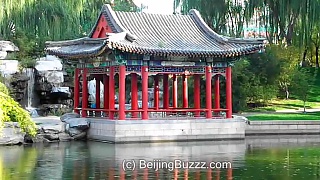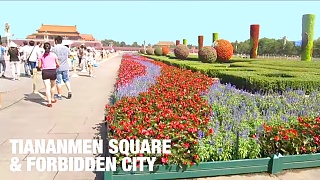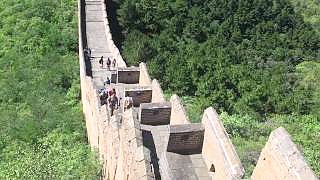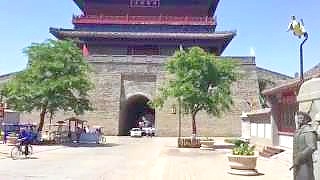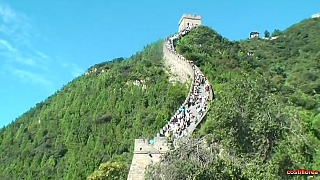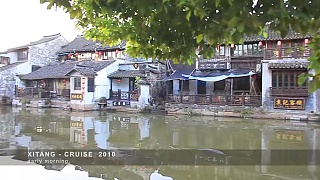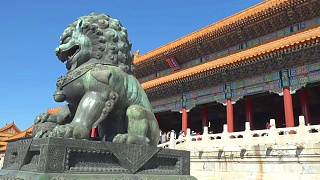The Great Wall of China is an immensely long man-made wall that was built to keep out invaders. The Great Wall spans nine provinces and its total length is 6,700 km (3,948 miles). The Great Wall extends from ShanHaiGuan (the 'Old Dragon Head'), a seaport along the coast of BoHai, in the east (near BeiDaiHe resort) to JiaYuGuan Pass in GanSu Province in the west. Like a giant dragon, the Great Wall of China winds its way across grasslands, deserts and mountains. Although the Great Wall was originally built for protection, the wall stands as a tribute to the amazing ingenuity of the Chinese. Listed as a World Heritage Site by UNESCO in 1987, the Great Wall ('Chang Cheng' in Chinese) is a true marvel and a testament to the long history of the Chinese Civilisation. Today, people from all over the world visit to walk on the Great Wall of China, to stand on a watchtower and view the wall snaking into the distance. This treasure is now protected so that future generations can see the Great Wall with the same wonder and amazement as we do now. Some parts of the Great Wall of China have almost disappeared. Some parts have been overwhelmed by the elements. Some have been by the desert. Others eroded by local people recycling the wall's materials for constructions in their villages. Nevertheless, the Great Wall in large part still stands in silent splendor, enduring the passage of time and greeting the changes of the seasons as it has done for many hundreds of years. The Early Great Walls The history of the Great Wall is a long one - it was built over many hundreds of years. Walls were first built to keep invaders away from the farming villages on the Chinese border. These walls were built at weak points in the natural landscape or where the threat was perceived as greatest. Some of these walls eventually became of greater strategic importance when the localised defences were gradually joined to form the Great Wall of China. At those times that the Chinese territory expanded northward, earlier walls became secondary defences when a more northerly wall was built. In the early days, the Great Wall was as much a demarcation of territory as a defence as such, but as the Great Wall became stronger, it's defence role increased. Where possible, natural barriers were integrated into the path of the wall. This is particularly true for mountains - their height was used to gain both a greater view and for advantage in defense. The Great Wall of China was built by soldiers, civilians, farmers and prisoners, primarily during three dynasties: the Qin, the Han and the Ming, although the Sui Dynasty and the Ten Kingdoms period also played a part. The building styles of each dynasty added their own flavor and advanced the techniques learned from the previous. The early Great Wall was located much further north than the current Ming wall, with its eastern end at modern day North Korea. Very little of this first wall remains - although aerial photographs do reveal a low, long mound. The Great Wall that the Ming created was, more or less, completely new. The Qin Dynasty Great Wall The first dynasty of China was the short-lived Qin Dynasty (221-206BC). The first emperor, Qin ShiHuang, was a tyrannical emperor who unified China by force and set about constructing one Great Wall - by joining, where possible, existing one and filling the gaps. He even sent scholars to work on the Great Wall - anyone who was deemed unproductive. These workers faced arduous labor, and the constant danger of being attacked by bandits. Most of the early Great Walls were composed of loose stone, but when the natural stone in an area was not sufficient, the engineers turned to another method of wall building - a stoneless wall that was built using a wooden, rectangular frame that was then filled with loose soil. The soil was trampled down for many hours by a team of workers until it was solid. This process of filling and trampling would be repeated over and over until the wall reached the desired height. The Han Dynasty Great Wall The second dynasty to add to the Great Wall was the Han Dynasty (206BC-220AD). This dynasty rose to power in 206 BC after the fall of the Qin. The most notable contribution of the Han Dynasty is that they extended the Great Wall westwards through the Gobi Desert. Despite a lack of building materials, ingenious Chinese engineers found a solution. Their answer was similar to that of the Qin, but created a stronger wall. This method involved first laying down a layer of willow reeds, possibly woven. Then a layer of gravel and a little water was applied and trampled solid. After the trampling, a new layer of reeds and gravel was added. This process would be repeated until the desired height was reached. Amazingly, some portions of this Great Wall are still standing, partly due to the dry conditions of the Gobi. The Han also improved the watchtowers of the Great Wall - making them two storied to gain a better lookout. The Ming Dynasty Great Wall The last dynasty to build a northern wall was the Ming Dynasty (1368-1644). This dynasty built the biggest, longest, strongest and most ornate Great Wall ever. These are the walls that we are familiar with today. The Ming Emperors, having overthrown the Mongols from the north, devoted large amounts of material and manpower to making sure that they (and the other semi-nomadic peoples to the north) could not return. Their methods of Great Wall building fused all that was learned by the two previous dynasties. First, a center of trampled earth was created. Then, around the firm center was applied a shell of stone and bricks. The bricks that were created by the Ming are so strong that they compare well with the ones we use today. Near Beijing, the Great Wall is constructed from quarried limestone blocks and fired bricks. The strong Ming wall was built across some of the most dangerous terrains in China, including steep mountains, sometimes on 75 degree inclines! It has been said that every foot of the construction of this Great Wall cost one human life. The Ming Dynasty Great Wall starts on the eastern end at ShanHai Pass, near QinHuangDao, in Hebei Province, next to Bohai Sea. It once spanned 9 provinces and 100 counties, but the final 500 kilometers of the Great Wall to the west have all but turned to rubble. Today, the western end of the Great Wall effectively ends at the historic site of JiaYuGuan Pass, in northwest GanSu Province, at the limit of the Gobi Desert and the oases of the Silk Road. JiaYuGuan Pass was intended to greet travelers along the Silk Road. Although the Great Wall now ends at JiaYuGuan Pass, there are many watchtowers extending beyond there along the Silk Road. In 1644, after two years of trying, the Manchus finally crossed the Great Wall by bribing an important general, Wu SanGui, to open the gates of ShanHai Pass and allow the Manchus into China. Legend has it that it took three days for the huge Manchu army to pass through the Great Wall. So began the Qing dynasty. After the Manchu conquered China, the Great Wall was of less strategic value, mainly because the Manchu extended their political control far to the north of it, much further than any previous Chinese dynasty. The last Great Wall of the Ming Dynasty was a military fortification of great strength. However, historians are sometimes dismissive of its net value. It was astonishingly expensive to build, maintain and garrison and the resources the Ming spent on the Great Wall could have been spent on other military capabilities. The fact remains that the Great Wall was of no help in preventing the fall of the Ming Dynasty. However, only because the currently prevailing dynasty had weakened from within were invaders from the north able to advance and then conquer. Both the Mongols (Yuan Dynasty, 1271-1368) and the Manchurians (Qing Dynasty, 1644-1911) were able take power not because of a weakness in the Great Wall but because of a weakness in the government. They took advantage of disenchantment and rebellion and stepped into the void of power without an extended war. WatchTowers Along the Ming Great Wall of China there are many watchtowers, spaced from less than a kilometer to several kilometers or more apart. These were partly used to transmit military messages. Fire and smoke were the most efficient means for communication - fire was used at night and smoke during the day. Straw and dung was used for this. In 1468, a series of regulations set specific meanings to these signals: a single shot and a single fire or smoke signal implied about 100 enemies, two signals warned of 500, three warned of over a 1000 and so on. In this way, a message could be transmitted over more than 500 km of the Great Wall within a few hours. During the Ming Dynasty, two-storied watchtowers were built on the Great Wall in strategic places. The ground floor was used for living, and storing food and weapons, and the top floor was used as a high lookout platform and also for defense. Canons were installed in strategic places, sometimes in watchtowers but also along the wall. The watchtowers also provided a place to retreat to, if necessary, from attackers who had scaled the Great Wall. Inside, the watchtowers have narrow and puzzling layouts to confuse any infiltrators. The internal passageways and staircases were unique and restricted. This allowed defenders to pick off attackers one by one. Barracks and administrative centers were located at larger intervals along the Great Wall. Small armies were garrisoned along the length of the wall to provide early warning of invasion and a first line of defense. The outer parapet of the Great Wall is crenelated with merlons almost 2 m high from the base of the wall. The merlons provided protection from incoming fire while the gaps allowed fire at invaders.





History and Significance:
Historical Significance: The Great Wall of China is a series of fortifications built over centuries to protect China from invasions by nomadic tribes from the north. Its construction began as early as the 7th century BC and continued through different dynasties, with the most famous sections built during the Ming Dynasty (1368�1644 AD).
Length and Structure: Stretching over 13,000 miles (21,196 kilometers), the Great Wall is not a continuous wall but a series of walls, trenches, and natural barriers, including mountains and rivers. Its main purpose was to provide defense and control trade routes along the northern border of China.
Visiting the Great Wall:
Sections to Visit: While the entire Great Wall is massive, certain sections are more accessible and popular among tourists. The most visited sections include Badaling, Mutianyu, Jinshanling, and Simatai. Each section offers unique features and experiences.
Badaling: This section is the closest to Beijing and is one of the most well-preserved and accessible sections of the Great Wall. It can be crowded, especially during peak tourist seasons.
Mutianyu: Located about 1.5 to 2 hours' drive from Beijing, Mutianyu offers a less crowded but equally impressive experience. It features restored sections as well as more rugged and original parts.
Jinshanling and Simatai: These sections are farther from Beijing but are known for their scenic beauty and relatively fewer crowds. They offer a more authentic and adventurous hiking experience.
Tips for Tourists:
Best Time to Visit: The Great Wall can be visited year-round, but the best times are spring (April to June) and autumn (September to November) when the weather is pleasant, and the scenery is beautiful.
Avoiding Crowds: To avoid crowds, consider visiting the Great Wall early in the morning or during weekdays. Badaling tends to be busiest, so opting for less-visited sections like Jinshanling or Simatai can provide a more peaceful experience.
Wear Comfortable Clothing: The Great Wall involves a fair amount of walking and climbing stairs, so wear comfortable shoes and clothing suitable for hiking.
Stay Hydrated and Sun-Protected: Bring plenty of water, sunscreen, and a hat, especially during hot summer months, as there may be limited shade on the Wall.
Respect the Environment: Help preserve the Great Wall for future generations by refraining from littering, defacing, or damaging the structure.
Cultural Insights:
Learn about the History: Take the time to learn about the history and significance of the Great Wall through signage, guidebooks, or guided tours.
Capture Memories: Don't forget to bring a camera or smartphone to capture the breathtaking views and memories of your visit.
Interact with Locals: Engage with local vendors, tour guides, or fellow travelers to gain insights into Chinese culture and customs related to the Great Wall.
Visiting the Great Wall of China is a once-in-a-lifetime experience that offers not only breathtaking views and photo opportunities but also a deeper appreciation for one of the world's most remarkable architectural achievements.
Beijing, the capital city of China, is a vibrant metropolis steeped in history, culture, and modernity. Here's a brief overview of what you can expect as a tourist in Beijing:
Historical Landmarks:
The Great Wall of China: One of the most iconic structures in the world, the Great Wall is easily accessible from Beijing. Mutianyu and Badaling sections are popular among tourists.
Forbidden City (Palace Museum): A UNESCO World Heritage Site, this vast imperial palace complex was home to Chinese emperors for over 500 years. It houses numerous halls, courtyards, and historical artifacts.
Temple of Heaven: A masterpiece of Chinese architecture, this ancient temple complex served as a place of worship for emperors to pray for good harvests.
Summer Palace: A stunning ensemble of lakes, gardens, and palaces, the Summer Palace served as a retreat for emperors during the Qing dynasty.
Tiananmen Square: One of the largest city squares in the world, Tiananmen Square is flanked by important landmarks such as the Monument to the People's Heroes, the Great Hall of the People, and the Mausoleum of Mao Zedong.
Cultural Sites:
Beijing Hutongs: Explore the narrow alleyways and traditional courtyard residences of Beijing's historic neighborhoods. You can take a rickshaw tour or simply wander around on foot.
Beijing Opera: Experience traditional Chinese opera performances at venues like the Liyuan Theater or the Chang'an Grand Theatre.
798 Art District: A hub of contemporary art and culture, this former industrial area is now home to numerous galleries, studios, and cafes.
Modern Attractions:
Olympic Park: Visit iconic structures such as the Bird's Nest (National Stadium) and the Water Cube (National Aquatics Center) from the 2008 Beijing Olympics.
CBD (Central Business District): Marvel at the futuristic skyline of Beijing's modern business district, which includes landmarks like the CCTV Headquarters and the China World Trade Center Tower III.
Culinary Delights:
Peking Duck: Indulge in Beijing's most famous dish, crispy roast duck served with pancakes, scallions, and hoisin sauce.
Street Food: Explore the city's vibrant street food scene and sample local delicacies like jianbing (savory crepes), lamb skewers, and dumplings.
Practical Tips:
Transportation: Beijing has an extensive public transportation system, including the subway, buses, and taxis. However, traffic can be heavy, so plan your travels accordingly.
Language: While English is not widely spoken, especially outside tourist areas, many signs and transportation announcements are in English. It's helpful to carry a translation app or a phrasebook.
Weather: Beijing experiences four distinct seasons, with hot summers and cold winters. The best times to visit are spring (April to June) and autumn (September to October) when the weather is mild and comfortable.
Etiquette: Respect local customs and traditions, such as removing your shoes before entering someone's home and using both hands to pass or receive items.
Beijing offers a rich tapestry of experiences for tourists, blending ancient heritage with modern innovations. Whether you're fascinated by history, culture, or culinary delights, there's something for everyone in this dynamic city.
 The Great Wall of China
The Great Wall of China
